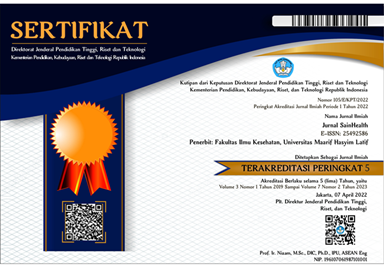KOMPARASI EFEK PEMBERIAN MINYAK JINTAN HITAM (Nigella sativa) DENGAN MINYAK ZAITUN (Olea europea) TERHADAP PENURUNAN GLUKOSA DARAH PADA MENCIT (Mus musculus) STRAIN Balb/c
DOI:
https://doi.org/10.51804/jsh.v1i1.76.36-42Keywords:
Cumin Oil, Olive oil, Mice (Balb/c), Dextrose 40%, Blood GlucoseAbstract
Diabetes mellitus is a disease in humans characterized by an increase in blood glucose levels exceeds the normal limits. Cumin oil and olive oil is an alternative drug to a decrease in blood glucose levels for people with diabetes mellitus. Cumin oil and olive oil has several compounds that can lower blood glucose levels in excess. This study was conducted in January 2015 for 3 weeks in PUSVETMA Surabaya. Animals used in the study were female mice 2-3 months old with an average weight of 20-25 grams of a much as 30 individuals. At a dosage of dextrose 40% is 0.4 cc/ head/ day and the dosage of cumin oil and olive oil is 0.7 cc/ head/ day. This a study conducted of mice that had been induced dextrose 40% by using a sample of a much as 30 female mice. The results of statistical independent t-test, there was no difference or both of the test sample may lower blood glucose levels among female mice were treated with cumin oil and treated with olive oil. While the results of the data was tested using SPSS statistical Paired t-test showed that effectively lower blood glucose levels are olive oil, because there is a significant difference between before and after administration of olive oil after 7 days of dosing.References
Al-Majed, A.A., F.A. Al-Omar, M.N. Nagi. 2006. Neuroprotective Effects of Thymoquinone Against Transient Forebrain Ischemia in the Rat hippocampus. European Journal of Pharmacology. 543: 42-47. http://docs.kso.edo.sa/PDF/Articles31/Article310245.pdf. Diakses 12 Maret 2008.
De Bruyne, L.K., Cataldo, C.B., and Whitney, E.N. 2008. Nutrition and Diet Therapy: Principles and Practice. 7th edition. Belmont: Wadseorth Thomson Learning.
Mangkoewidjojo, S. 2003. Hewan, Eksperimentasi Hewan, Profesi Dokter Hewan, Peranan dan Masalahnya di Bidang Biomedik. Universitas Gadjah Mada. Yogyakarta.
Meral, I., N. Donmez, B. Baydas, F. Belge and M. Kanter. 2004. Effect of Nigella sativa L. on Heart Rate and Some Haematological Values of Alloxan-Induced Diabetic Rabbits. Scand J. Lab. Sci. 31(1): 49-53.
Miladiyah, I., Purwono dam S. Mustofa. 2003. Efek Ekstrak Eter Daun Ceplukan (Physalis minima Linn) Setelah Pemberian Jangka Panjang Terhadap Kadar Gula Darah Tikus Diabetes. Majalah Obat Tradisional. 8 : 10.
Nickavar, B., F. Mojab, K., Javidnia, M.A.R., Amoli. 2003. Chemical Composition of The Fixed and Volatile Oils of Nigella sativa L. from Iran Zeitchrift fur Nature Forschung. 58: 629-631. http://www.znaturforsch.com.com/ac/v58c /558c0692.pdf. Diakses 8 Maret 2008.
Nolte, M.S. dan Karam, J.H. 2002.Hormon Pankreas dan Obat Anti Diabetes dalam Basic dan Cliical Pharmacology.8th ed. Katzung. B.G. (ed) McGraw-Hill Companies Inc. 271-710.
Suryanto. 1993. Pengantar Analisis Kompleks. ITB Press. Bandung.
Tjokroprawiro, A. 2006.Hidup Sehat dan Bahagia Bersama Diabetes Melitus. Gramedia Pustaka Umum. Jakarta. http://jurnal.pdii.lipi.go.id. Diakses 20 September 2011.
Wiryowidagdo, S. 2014. Hasil Penelitian Uji Efikasi Obat Herbal Untuk Meningkatkan Kadar Hemoglobin, Jumlah Trombosit dan Eritrosit dalam Hewan Uji Tikus Putih Jantan. Pusat Studi Bahan Alam. Departemen Farmasi. FMIPA UI. Depok.
Yulianti, S. dan E. Junaedi.2007. Sembuhkan Penyakit dengan Habbatussauda (Jitan Hitam).Agro Media Pustaka. Jakarta.
Downloads
Published
Issue
Section
License
Jurnal SainHealth is licensed under Creative Commons Attribution 4.0 International License.
Under the following terms:
Attribution — You must give appropriate credit, provide a link to the license, and indicate if changes were made. You may do so in any reasonable manner, but not in any way that suggests the licensor endorses you or your use.
No additional restrictions — You may not apply legal terms or technological measures that legally restrict others from doing anything the license permits.
















